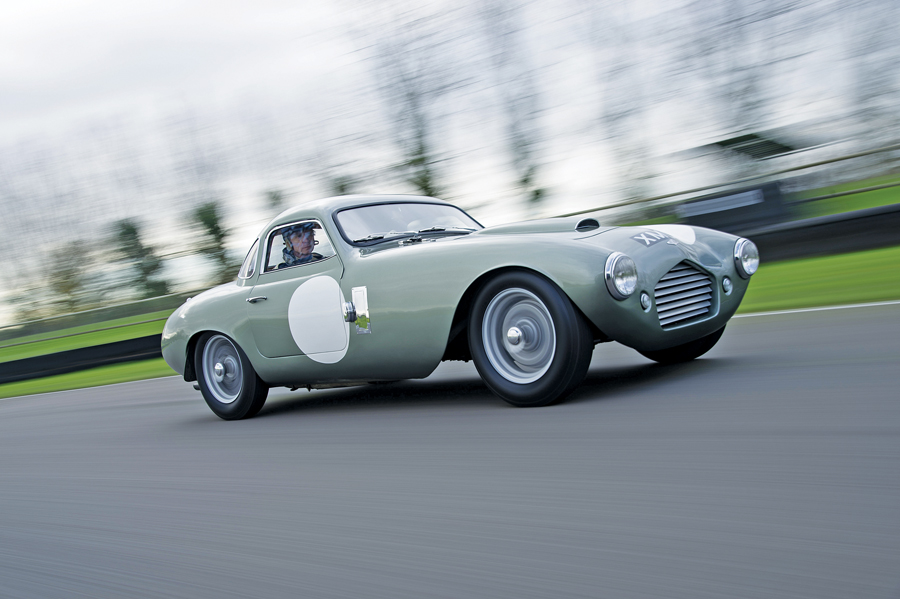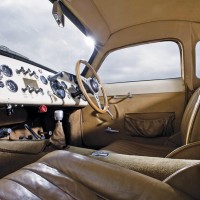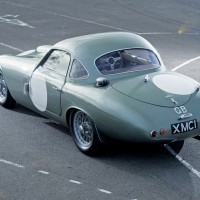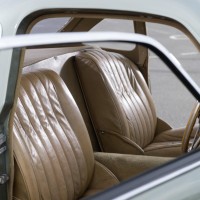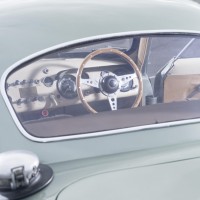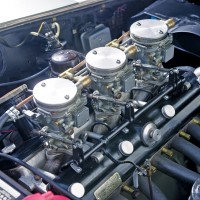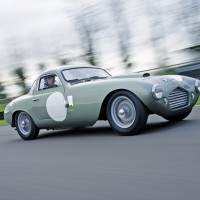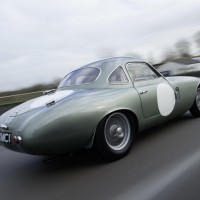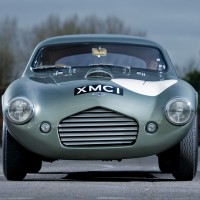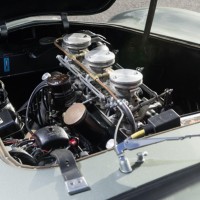SCM Analysis
Detailing
| Vehicle: | 1955 Frazer Nash Le Mans Coupe |
| Years Produced: | 1953–55 |
| Number Produced: | Nine |
| Original List Price: | $6,850 |
| SCM Valuation: | $500,000–$650,000 |
| Club Info: | Frazer Nash Car Club |
| Website: | http://www.frazernash.co.uk |
| Alternatives: | 1956–63 AC Aceca Bristol, 1953–55 Aston Martin DB 2/4, 1951–58 Lancia B20GT |
| Investment Grade: | B |
This car, Lot 26, sold for $693,148, including buyer’s premium, at Bonhams’ Goodwood auction in Chichester, U.K., on March 21, 2015.
A what? I’ll admit that Frazer Nash isn’t a manufacturer’s name that leaps to mind.
The few people who do know of it tend to assume that it was one of those weird little pre-war builders that built quirky, primitive racers (something about “chain gang”) and didn’t survive World War II. In fact, Frazer Nash not only survived the war, they did very well, and in various evolved forms, continue to do well to this day.
They didn’t build a lot of cars before the war and even fewer after, but they were anything but a struggling, quixotic little company. Let’s start with some history.
More than 100 years ago…
In 1910, two young engineers, a Mr. Godfrey and Archibald Frazer-Nash, started a company to manufacture very simple, inexpensive belt-drive cycle-cars, called GN. They proved to be remarkably good performers for the price and enjoyed immediate success. During World War I, a multiple-chain transmission was developed (think of three or four bicycle sprocket/chain setups side by side, shifted by sliding dog gears) to improve power transmission and reliability.
After World War I, more competition dimmed prospects, and in 1923 the two founders left the company. Archibald formed a new company — Frazer Nash — to build an improved car along the GN lines, but with emphasis on sporting performance rather than economy. The new Frazer Nash proved to be an amazing performer, particularly with the chain-drive transmission that allowed very fast shifting compared with other transmissions of the time.
The company did well for a few years, but a business downturn combined with health issues to force Archibald out, and he sold the company to H.J. Aldington. The new company, AFN, built about 360 chain-drive Frazer Nash cars through the 1930s, establishing a fearsome reputation for the cars as highly competitive and cheerfully nonconformist racers.
The aficionados called themselves the “Chain Gang” and still do.
Possibly as important, Aldington was an adventurous entrepreneur and, on a racing and touring trip through Europe in 1934, he became acquainted with the BMW car company in Munich. He arranged to become the BMW importer for England, badging them as the “Frazer Nash BMW” and doing rather well in the process. Everything ended, of course, with the onset of World War II in 1939.
Building a few good cars
Immediately after the war, Aldington returned to Munich and, in a combination of astute business acumen and war reparations, managed to bring the design rights to the now legendary BMW 328 and its designer, Fritz Fiedler, back to England. The Bristol Aircraft Company was looking to diversify into automobiles after the war, and arrangements were made to share the rights, with Bristol building the 2-liter 328 engine as a “Bristol” under license and Frazer Nash effectively building an updated 328 sports car under its own nameplate.
The essential point here is that Aldington was an excellent and successful businessman who obviously created multiple sources of revenue to support his passions (he became the U.K. importer for Porsche in the early 1950s). In the post-war years (through 1958), Frazer Nash built about 70 cars (records weren’t great).
Building cars was not a hand-to-mouth struggle to keep the doors open, and AFN was anything but a “normal” car company. Frazer Nash built cars because they wanted to and could afford to do it, and they sold to the few people who could afford to buy them.
As you might expect from such an arrangement, the cars they produced were highly individual. With the exception of our subject Le Mans coupe, they were all open cars. By far the most common and recognizable (34 built), were the first of the post-war cars. The High-Speed was a cycle-fendered, English-built BMW 328 designed almost strictly for racing. When one finished 3rd at Le Mans in 1949, the later cars were called “Le Mans Replica” in its honor, and all of them now go by that moniker.
On to the Le Mans coupe
It was also the last of the cycle-fender cars. Technology and aerodynamics marched forward, and Frazer Nash started to build sports cars that pretty much looked like the modern definition.
In 1953, they introduced the Le Mans coupe, which was designed with high-speed aerodynamics and long-distance comfort in mind. It proved to be a splendid little car, tiny on the outside but comfortable once you got yourself folded into it — with an amazing amount of luggage space in the boot for touring (or a big gas tank for distance racing).
The combination of the 2-liter Bristol engine and the lightweight aluminum body made the car very quick for its time, and it ran comfortably at 120 mph or more. In many ways it can be considered the first truly modern aerodynamic GT car, predating the Lotus Elite by four years.
Toy, tool or investment?
So here we are in 2015, 60 years after this car was built — and almost as many since the marque ceased production. What are we to make of it as a toy, a tool or an investment? I will argue that the results are mixed.
As a toy it is great. My shop maintained this car for a number of years, so I know it well and it really is a wonderful little car, fun to drive, easy to maintain and strikingly handsome.
As a tool for competition it also fares very well indeed. These cars raced at all the important venues in the day: Le Mans, Mille Miglia, Goodwood and scores of others, so it is instantly welcome at the modern versions of these events that have become very difficult for most cars to enter.
Once there, you can be as competitive as you want to be: Fire-breathing (ostensibly vintage) Bristol engines are available with a phone call if you want to go fast, and the chassis will handle it well. The glory of high-profile vintage racing is a specialty of Frazer Nash.
As an investment, I’m not quite so sure. It does seem to have everything going for it — rarity, beauty, aluminum bodywork, racing history, usability and the like, but somehow it remains more of an enthusiast’s car than an investor’s vehicle.
I am aware of what this very car sold for privately in 2004 and 2010 — as well as the current auction value. Although it has increased generally in pound sterling, in U.S. dollars the value growth has remained unspectacular — while other cars have skyrocketed.
After some thought, I came up with a number of limiting considerations:
1. It’s not Italian.
2. It’s not mechanically exotic (Bristol engines are cool, but…).
3. It’s not wildly fast.
4. It was never particularly important.
Finally, nobody knows what a Frazer Nash is (or was).
Thus, the Le Mans coupe is what I would call an excellent pure enthusiast’s car: a relatively safe place to put your money while you go have a great time with a car that you love, but it’s not a mechanism for value appreciation. As such, I would say fairly bought. ♦
(Introductory description courtesy of Bonhams.)
